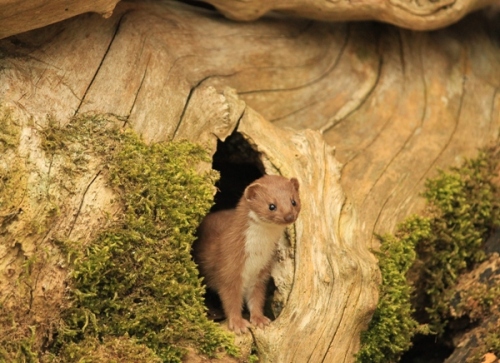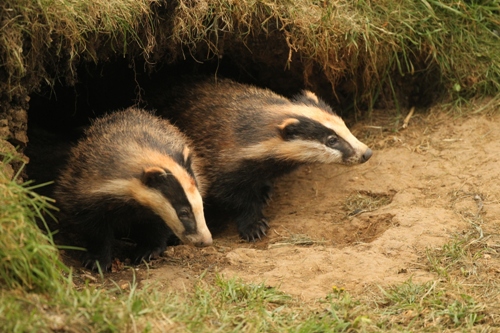I’ve endured the icy winds of Antarctica in order to photograph wildlife for my paintings. But nothing in that cold climate compares to my ordeal of watching courting hares on the Yorkshire Wolds one Christmas.
As the country came to grips with one of the iciest cold snaps in decades, I spent 10 days trudging through thigh deep snow, sometimes for eight hours a day.
When it snows up here, it really snows, and when it blows, it really drifts. Getting close to the hares in these conditions was one of the harshest consignments of my career.
Hares don't just box and breed in spring, although this is the climax of the season, it can happen at any time of year and they can have three or four litters a year.
They seem to favour specific fields for their courtship, which they return to time and time again, and if you happen to discover the spot I’ve always believed it worth the effort it takes to watch them.
I had been out on a drive through the white wintery
landscape looking for owls and had already taken a great picture of a tawny owl
roosting in an ash tree: a dusting of snow around its hole and a few flakes on
its head.
The hares, sat tight in individual dug out holes in the snow
and facing away from the biting wind, were a little far from the road so I
grabbed my camera and tripod and headed across a large arable field. The snow
was particularly deep and it was heavy going.
As I struggled through the drifts, which were above my waist
on the edge of the road, I spotted four more. They shuffled down deeper into
the snow as I approached and flattened their ears to their bodies until only
their eyes were visible, peeking above the snow line.
I took a few shots of the courting couple and then the snow
seemed to explode behind them as they leapt up and dashed away into the
distance.
The other four hares took chase - there was a female in
season and the males weren't going to let her out of their sight.
It was difficult getting close enough for a good photograph,
but I found that if I took heed of the wind's direction and moved slowly,
sniper-like I could get surprisingly close. Whenever the hares looked alarmed I
would stay still and resume my tentative approach when they settled down again.
But it took up to an hour to get really close and it was
bitterly cold out on the exposed field. Whenever a large snow storm came over
the hares hunkered down with their backs to the wind all in a line, but in
between the storms males would go around the group testing the female’s
receptivity. They were usually quickly rebuffed with a swift box from the
female, who lay partially hidden in snow dugouts.
I used the blizzards whiteouts to get a little bit closer
still. But as the weather cleared they spotted me and were uneasy with my
proximity.
In my habitual green camouflage gear I stuck out like a sore
thumb in contrast to the pure white landscape.
The hares dashed through a hedge into the next field. I used
the hedge as cover as I approached them and then peered over into the next
field. I spotted a larger group out in the middle of the field - there were
eight in this new group and I could see still more in the distance – 20,
perhaps 30 hares in total.
With so many pairs of eyes looking out, I was quickly
spotted and they dashed over the horizon.
I followed them to the bottom of the field and was on the
brink of giving up when I spotted a few doubling back on me.
As well as using the same field again and again, hares also
like to court in the same place on a specific field and it turned out that spot
was just behind me.
From my hiding place I counted 24 hares bouncing over the
horizon towards me and then they joined into a group of 32. Hares seemed to be
coming from all directions.
Within 20 minutes there were 51 hares in front of me - I couldn’t
contain my excitement. To see so many at one time is extremely rare and this
was the most I’d seen together in Yorkshire .
This meant there must have been at least 20 females in season. I might have
been alone on a bleak hill top in the middle of a blizzard witnessing, but I
was delighted.
I pushed the biting wind to the back of my mind, but when
another heavy snow storm came in and the light faded for the day I headed for
home.
I needed to come up with a plan of how to get back there and
photograph them again - but this time unseen.
A hide I decided wouldn't be practical; I needed to be able
to move about quickly. So it came down to getting the right clothing - white
clothing.
I decided to make myself and my camera a little outfit out
of a white tonne dump bag held together with a few cable ties and some string.
This rig up worked well on the camera and tripod, but my
attempt at making a jacket and trousers rustled noisily when I walked. I did
however make myself quite a convincing 'balaclava' out of a (white) pillowcase
and I cunningly swiped our (white) oven gloves from the kitchen.
Then I had a brainwave - an all-in-one spray suit (in white,
of course) - is what I needed. So the following morning I headed into Yates of
Malton and bought myself an XXL suit which was large enough to go over all my
layers of clothes.
I drove out to the field, with my snow camouflage outfit in
the back of my car. I was just putting my gear on when a tractor approached so,
feeling a little self-conscious, I hesitated, until he had gone by.
But the tractor kept coming and going so I decided to venture
out in the field and put the gear on once I spotted the hares.
I soon located them again, but getting changed in 18” of
snow and a ripping wind was easier said than done. I had to lie on my back with
my boots off trying to control the white spray suit which was trying to fly off
in all directions.
I did look a bit of a sight in my white kit, but I quickly
'blended' into the general whiteout.
I counted the hares: there were 14 in the group and more on
the horizon. I set off after them with the confidence of invisibility, but much
to my annoyance they spotted me straightaway - I was silhouetted in white
against a dark woodland background.

I let the hares settle and re-planned my approach to blend
in with a white backdrop of neighbouring fields. Each time a snowstorm came
over I edged closer and now had a coating of snow to add authenticity to my
outfit.
Behind me my footprints had already been covered by drifting
snow. My camouflage had got me within 25 yards of the hares.
They spent much of their time hunkered down with the snow
whipping around them in great swirls. I spent day after day photographing them,
mainly in overcast or blizzard conditions and sub-zero temperatures.
On the first sunny day of the week I headed off with a great
expectation, despite the fact that it was -14C when I set off. But actually the
crisp calm conditions proved more difficult as the hares could hear my every
footstep crunching through the snow and the sun played havoc with the auto-focusing
on my camera, due to a sort of heat haze coming off the snow.
It was fascinating to watch courting hares in such harsh
conditions and such a marvellous end to my wildlife watching year. The leverets
from this courtship may be among the first to be born in the New Year.







































